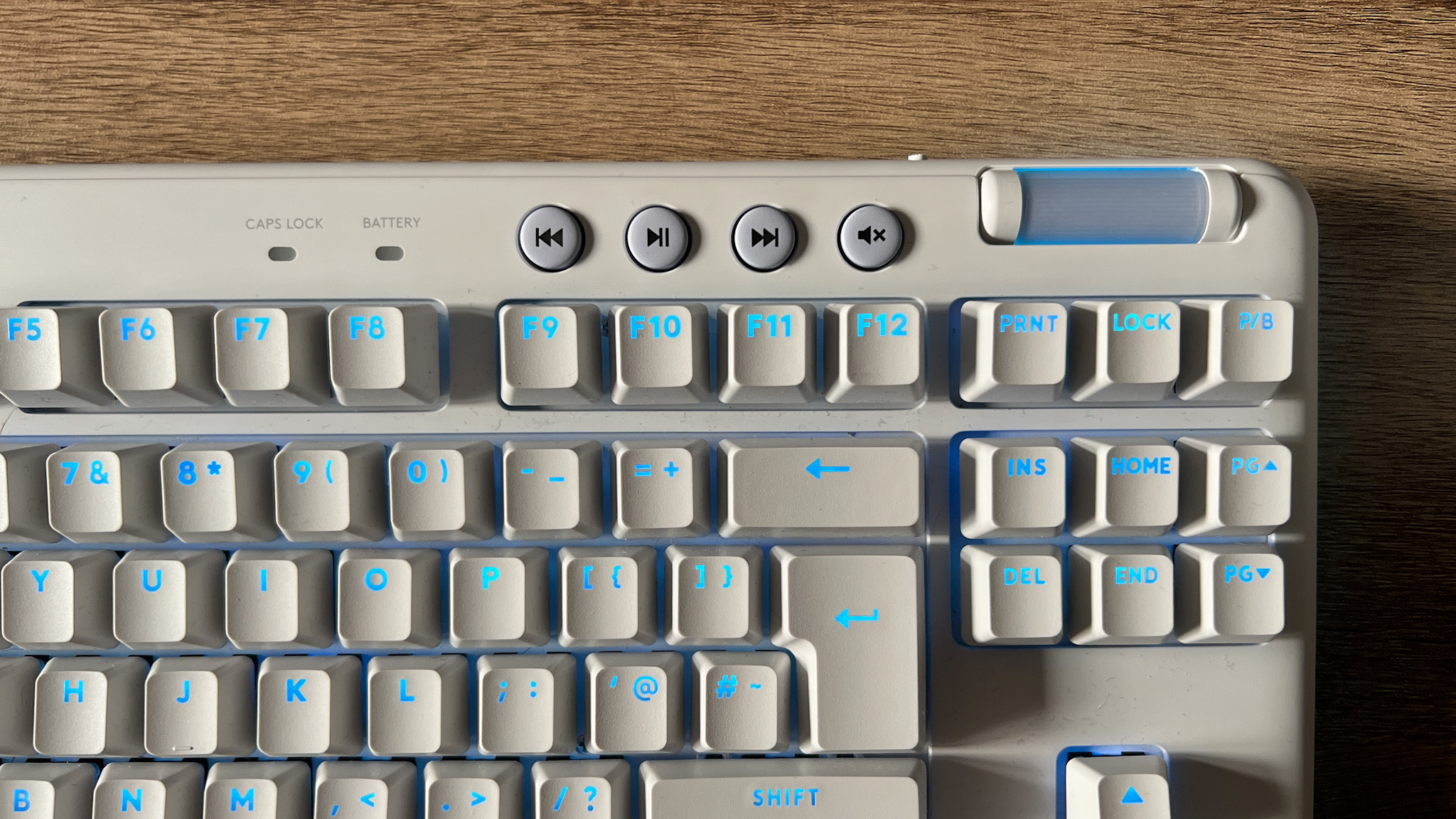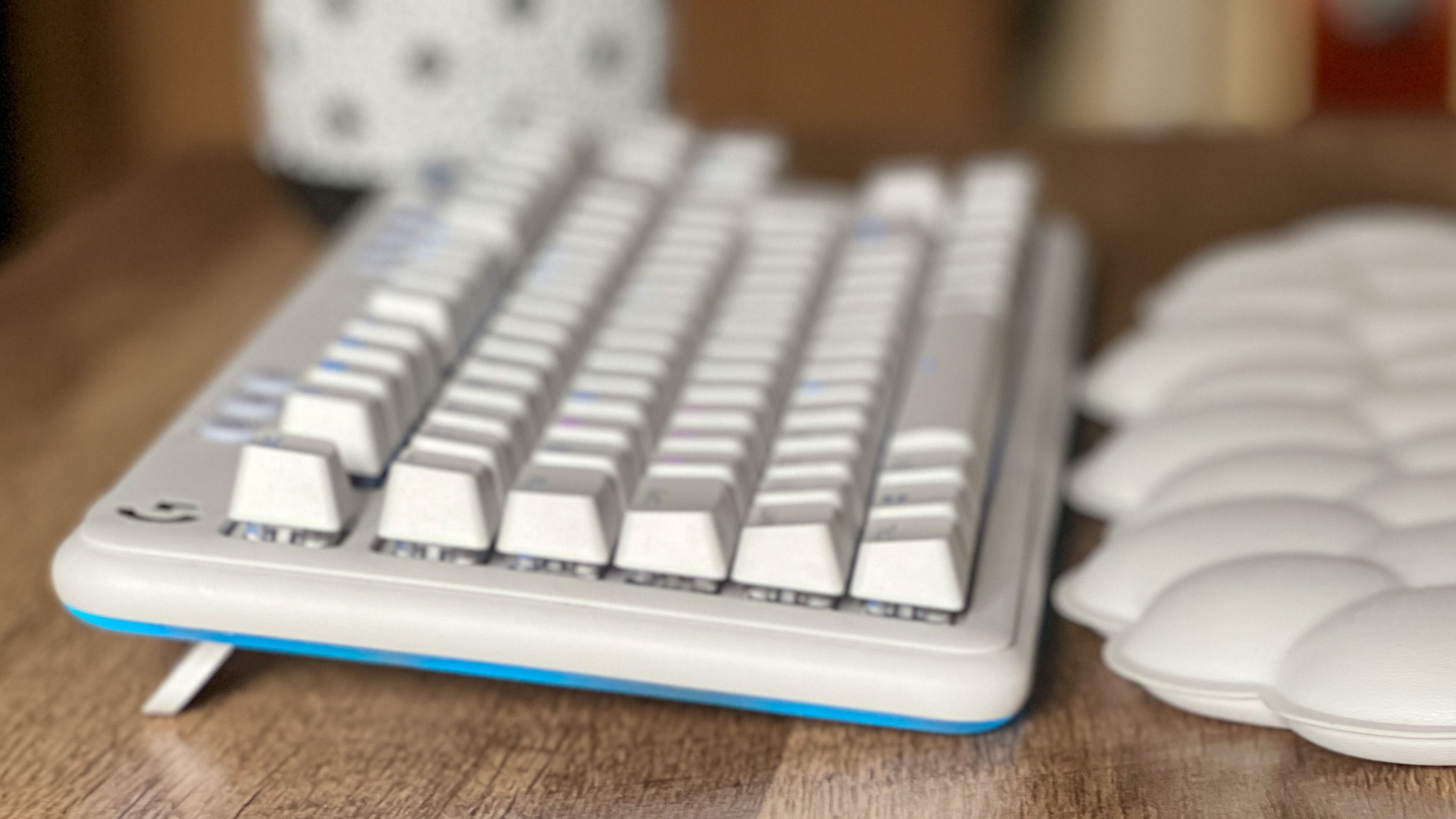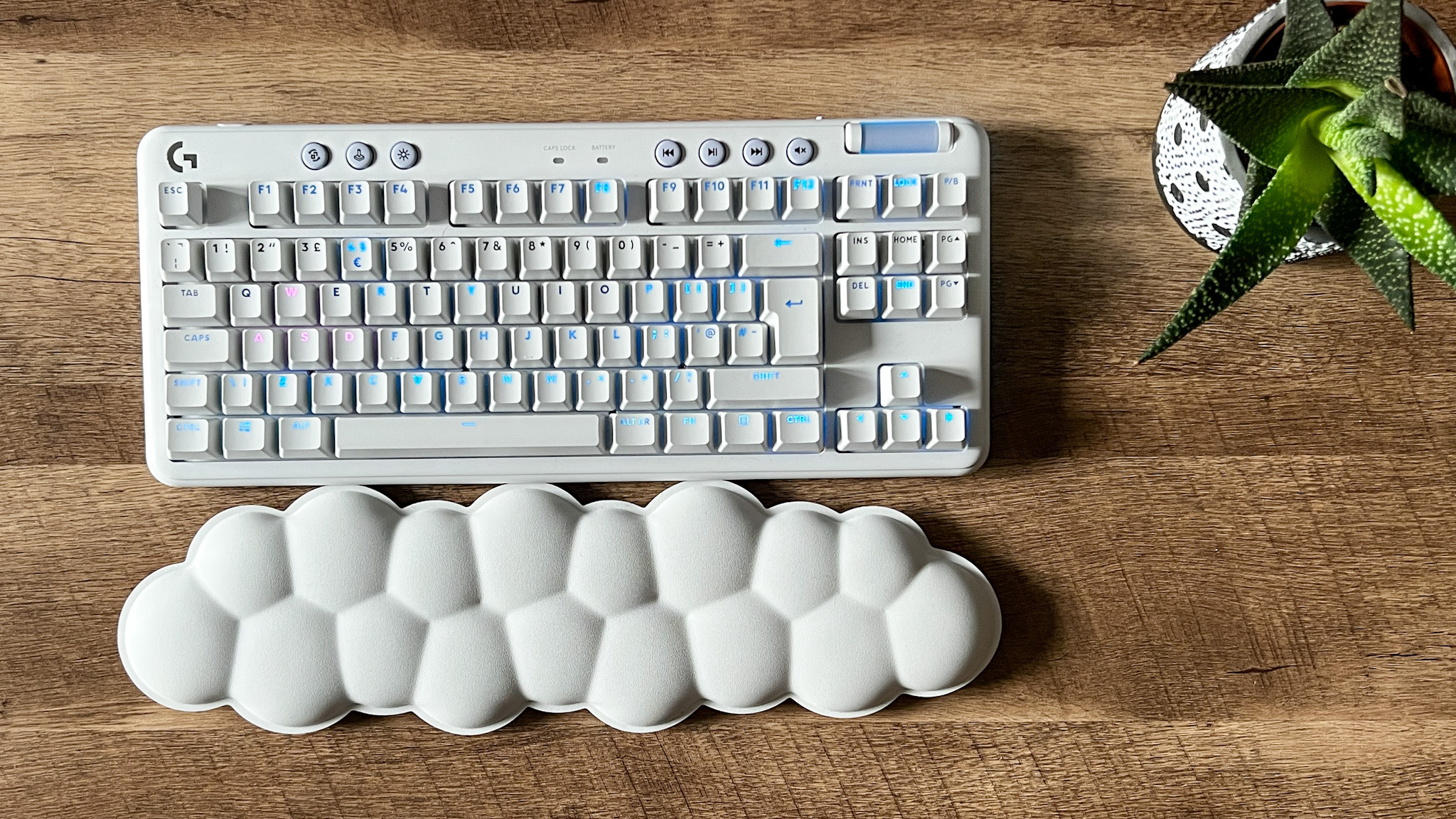GamesRadar+ Verdict
The Logitech G715 is an excellent gaming keyboard - for those who can afford to splash out on a particular aesthetic. With a particularly tactile experience overall and some solid speed under the hood, this is a powerful deck wrapped up in a cosy pastel aesthetic.
Pros
- +
Unique aesthetic
- +
High quality keycaps
- +
Smooth GX switches
- +
Long-lasting battery
- +
Cloud wrist-rest included
Cons
- -
A fully customizable deck is expensive
- -
Can get the same features for less
Why you can trust GamesRadar+
The Logitech G715 keyboard brings a softness to an otherwise hard, angular market. From its curved edges to the literal cloud of a wrist rest, this is an exercise in pastel colors, smooth matte finishes, and customization. Don't be fooled by this warm and fluffy exterior, though, there's still a cold, hard gaming machine underneath with all the speed and fury one can expect from a top tier device.
This is no kids version either. The G715 starts life at a $199.99 / £179.99 base price, and that's before you add the costs of different colored faceplates and keycaps to the equation. We did the math, and fully kitting this out as Logitech intended would set you back $276.99 / £245.99. That's more than the Razer Huntsman V2 Analog - the best gaming keyboard on the market right now.
Still, if you're after a particular aesthetic, the Logitech G715 may well get you straight there - with additional customization options to boot. We put the TKL deck to the test over the course of three weeks to see how it fares.
| Type | Mechanical |
| Connection | Wireless Lightspeed / Bluetooth |
| Size | TKL |
| Switches | GX Linear / Tactile |
| Keycaps | Doubleshot PBT |
| Media keys | Dedicated + volume roller |
| Wrist rest | Included |
| USB passthrough | No |
Logitech G715 Design
There's no doubt about it, the Logitech G715 is a good looking keyboard. With cozy rounded corners and soft LED lighting bleeding around the edge of the main deck, you're certainly bucking the all-black all-angles trend of the current gaming keyboard market here. The matte plastic material is pleasant to the touch, and adds to the relaxed vibe - but I did notice it collecting (and holding onto) any crumb of dust the instant it entered the atmosphere. There is, after all, a reason you don't see too many white gaming keyboards and I don't know how long this pliable plastic will stay looking crisp and clean when under longer term use.

Of course, it's hard to pull off a pastel design without that blank white canvas, and that aesthetic is one of the things I loved the most about the Logitech G715. There's nothing ostentatious or aggressive about this design - something that can't be said for the majority of decks on the shelves. With a thick, chunky build, and those comfortingly dull edges there's something relaxing about this step away from the language we've come to accept.
That doesn't mean this is a stripped-back deck. The glowing RGB around the edges and per-key LEDs will certainly make sure you know you're picking up a solid piece of kit. This lighting is actually surprisingly powerful, considering the laid-back vibe running across the whole device, but won't give Logitech's more mainstream bulbs a run for their money.
Then you've got the included cloud wrist rest. This is one of the more unusual aspects of the Logitech G715, but it's a nice addition in-keeping with the rest of the keyboard's themes and is surprisingly comfortable to boot. I did notice that some of the ridges became a little annoying when placed in certain positions, but lined up with the deck head on, my palms felt neatly supported between the padding.
Logitech G715 Features
You can pick up the Logitech G715 with the brand's own linear, tactile, or clicky switches (though the clicky option isn't available in the UK). These GX switches are remarkably smooth compared to the usual Cherry suspects - the blues we tested were crisp and snappy but did come with their trademark volume level. Still, I sometimes prefer the feedback of a clickier switch, and was particularly satisfied with the clean auditory profile here - especially considering they felt light to actuate and sit underneath a particularly soft set of doubleshot PBT keycaps.

The G715 is a wireless gaming keyboard, but you've still got the option to connect via the USB-C cable, with the choice of connecting by Bluetooth or through the brand's own Lightspeed 2.4GHz dongle. I didn't notice anything particularly fast about Lightspeed compared to other brands, and haven't on previous Logitech keyboards, but it's still plenty fast for gaming.
Running along the top bezel, there's options for Bluetooth pairing, game mode (to lock the Windows key), and RGB brightness and preset cycling. You'll find 8 RGB modes loaded onto the keyboard already, with plenty more options to be created in G Hub.
Of course, the biggest aesthetic feature is the swappable face plates. While we didn't receive any additional color options to test out, it's a nice to have if you can afford to splurge. Of course, these are bonus points - nobody's going to force you to pick up the extra plates when you first pick up the G715, but it's nice to know there are different $20 options out there for if you feel like a change.
Logitech G715 Performance
The Logitech G715 does feel great under the hand, with those PBT keycaps offering up a particularly satisfying surface, and the crisp switches under the hood keeping everything snappy. The tactile bumps we received performed particularly well in faster paced games, returning to full height with more than enough time to make repeated presses comfortable and easy.
That was only compounded by the nicely spaced, well-sized keycaps - ensuring precision and speed from a design point of view as well. Sensitivity also felt perfectly tuned to avoid unwanted keypresses, but that actuation bump generally saved me from any missteps as well.
I was also particularly impressed by the battery, serving up a commendable amount of active time per full charge. I was using this rig for everyday work for a full week (with cycling RGB effects) before having to plug in, and never experienced any dropouts when that charge was low either. That's likely due to the quick shutoff during inactivity - something that may have proved frustrating if the G715 wasn't so fast to boot back up at the whisper of a keypress.
Should you buy the Logitech G715?

The Logitech G715 is still a pricey keyboard, and there's no performance enhancements or additional features here that you can't find on other cheaper TKL models. However, the quality of those tactile switches will satisfy anyone on the hunt for a particularly clacky build, and the aesthetic is one we don't see too much of in this classically angular market. If the design speaks to you, there's nothing like the G715 on the market right now, but if you're after function over form you can certainly pick up a far cheaper model and still feel that speed and precision. The Logitech G713, for example, shaves $20 / £40 off the price tag by sacrificing wireless functionality.
Or, we'd recommend taking a look at the Corsair K63 Wireless if you'd like to keep that cable-free setup - while it only ships with linear Cherry MX Reds, you'll regularly find it for under $100 / £100. If you're happy to scrap that TKL form factor, we also loved the snap of the SteelSeries Apex 5 hybrid switches. Yes, you're dropping down to ABS keycaps here, but you're spending far less, picking up a full deck and still grabbing some particularly satisfying keys.
How we tested the Logitech G715
I used the Logitech G715 keyboard for all daily work and play over the course of three weeks, running the deck in 2.4GHz, Bluetooth and wired connections across Shadow of the Tomb Raider, Fall Guys, and Planet Coaster. I completed two full battery run-down tests during this time, charging to full capacity and using consistently without topping up. For more information on how we test gaming keyboards, check out our full GamesRadar+ Hardware Policy.
For even more customization options, check out the best hot-swappable keyboards on the market. Or, take a look at the best Razer keyboards for a different brand.

Managing Editor of Hardware at GamesRadar+, I originally landed in hardware at our sister site TechRadar before moving over to GamesRadar. In between, I've written for Tom’s Guide, Wireframe, The Indie Game Website and That Video Game Blog, covering everything from the PS5 launch to the Apple Pencil. Now, i'm focused on Nintendo Switch, gaming laptops (and the keyboards, headsets and mice that come with them), PS5, and trying to find the perfect projector.



